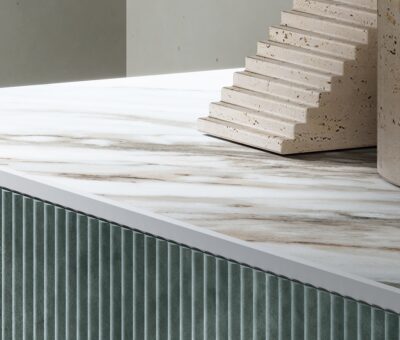The History of Granite with Rudi’s Choice
As the oldest igneous rock in the world, it’s no wonder granite is synonymous with opulence and grandeur. Let’s explore the history of this amazing feature and how it is still appreciated today.
First formed 300 million years ago, this sturdy rock has a rich history. Granite’s created when molten stone, also known as magma, cools. After which, it slowly crystallises long before it can reach the earth’s surface. Ancient monuments and buildings made from granite are still standing today – while the modern use of this durable stone remains popular thanks to the wide variety of available colours. Learn more about this classic stone as we look deeper into its history and how it is used in design today.
The Formation of Granite
Getting from quarry to countertop is a long process for this sought-after stone. The slab in your kitchen was once molten rock that slowly cooled and crystallised deep below the surface. Different quantities of rock and minerals, and the rate at which they cool over time, cause naturally occurring variations in colour, tone, granularity, and pattern. These variations attribute to what makes each piece’s natural beauty.
Granite is mined globally in several countries, including Brazil, India, Italy, Spain, China, and America. A block is cut by teams of people using specialised equipment to break the granite free. These teams drill small holes to outline the desired size. Afterward, they place explosives inside to blast the granite from the bedrock, which is directed onto soft sand to avoid cracking or splitting. After mining, it’s milled, cut, and polished into slabs – transported internationally to display showrooms for you to find your perfect piece.
Granite in History
Granite has been admired for centuries and used to create ancient cities, monuments, and burial chambers. There is evidence of granite used in ancient Egyptian pyramids – both as building materials and decoration – and in Roman times for building, paving, and constructing iconic monuments like the Pantheon. Mining granite was an arduous task involving many labourers using hammers and chisels, cutting holes into the stone, and then inserting wooden wedges soaked with water to expand and swell, causing the rock to split. This costly work meant that only the elite could afford to use granite in their designs.
Modern Granite
After the Renaissance, when they discovered more efficient ways to quarry granite, it naturally became easier to acquire, making its use more widespread. Although still costly, it was used by the wealthy for luxurious baths and pools for private use. It is a popular choice for residential and commercial design due to its durability, strength, and timeless aesthetic appeal. The wide variety in colours and patterning has made it a popular choice in interior design for features like countertops, flooring, tiling, and accent features
Granite Maintenance
Since granite is a natural stone, it does need sealing to create a nonporous finish and protect it from stains. It’s done at installation and resealed every few years for maintenance. When you seal your granite countertop properly, daily care is a breeze. Use a soft cloth to dust the surface or wipe it down with plain water or mild soap. For additional cleaning, use a specially formulated stone cleaner with a neutral pH. Never use abrasive cleaners or harsh chemicals. Sure, it’s extra work, but it is worth the effort. With the proper care, your countertop can add value to your home and provide a lifetime of enjoyment.
Colours
Granite consists of minerals and rocks, primarily quartz, potassium feldspar, mica, amphiboles, and other trace minerals. Granite typically contains 20-60% quartz, 10-65% feldspar, and 5-15% micas. The minerals that make up granite give it the unique colouring we see today. This natural stone must contain a minimum of 20% quartz to be categorised as granite, so a completely white or completely black slab is not technically granite.
Another factor in the colour of granite is the source of molten rock that cooled to form the stone. If the molten rock contained a lot of potassium feldspar, the granite is likely to be a salmon-pink colour. On the other hand, if the molten rock is abundant in quartz and minerals that make up amphibole, you will likely get a black and white speckled granite commonly seen on countertops.
Granite tones offer trendy textures and combinations of milky white to black and brown or grey in varied patterns ranging from cosmic swirls of galaxy-like striations to subtle speckled skies. Whether you prefer a traditional look or a striking statement, there is one suited to your taste.
More About Rudi’s Choice
Rudi’s Choice is South Africa’s premier quality marble, onyx, and granite supplier. The Granite Collection includes a hand-selected range of the best marble sourced internationally to bring quality and natural beauty to your design project.
Visit Rudi’s Choice for more.
You might also like...
-
Neolith Nurturing Architecture

In 21st-century design, architectural spaces are taking on a deeper purpose: nurturing both body and mind. Nurturing architecture emerges as a movement that ...
-
It’s A New Chapter with Fabri: A Kitchen as a Sanctuary in 2025

In 2025, the kitchen is more than just a place to cook—it’s a space to reset, recharge, and find calm amid the chaos of daily ...
-
Contemporary Designer Bathrooms: Where Style Meets Innovation

Contemporary designer bathrooms are rewriting the rules of interior architecture. Once purely functional, these spaces have been reimagined as luxurious sanctuaries where style and serenity ...
-
Max on Top Presents 2025-2026 renewed Arpa material explorations

Transform spaces with Arpa® decors to create refined and welcoming atmospheres. The 2025-2026 renewed Arpa’s material explorations feature two wood-inspired and five stone-inspired decors combined ...



























